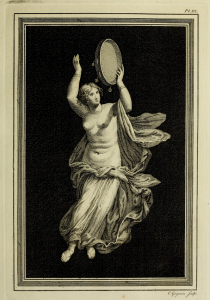From Italy to Britain II
Herculaneum and Pompeii
The ‘lost’ cities buried by the eruption of Mount Vesuvius in AD 79 were rediscovered in the eighteenth century and objects found there also inspired interior decoration, painting, and pottery. Winckelmann’s Open Letter on the Discoveries at Herculaneum, first published in German in 1762 and quickly translated into English and French, was one of a number of works to publicise the finds and criticise the conduct of the excavations. In this work and a further Report, published two years later, Winckelmann described various newly discovered artworks, including ancient paintings that today are faded or destroyed. He praised the dancers painted on the walls of Herculanean houses as ‘fleeting as a thought and beautiful as if they were drawn by the Graces’. Yet he also admired the beauty of humbler objects such as household vessels:
What deserves our attention most, in the utensils of the ancients, particularly their vessels, is the elegant form of them; a circumstance, in which all our modern artists must yield to the ancient. All those beautiful forms are founded on the principles of good taste, and may be compared with those of a handsome young man, whose attitudes abound with natural graces. It may be said, that this gracefulness extends even to the handles and ears of their vessels. Would our artists but endeavour to imitate them, their works would soon put on another face. (Anon. trans. from the French, 1771, p. 78)
